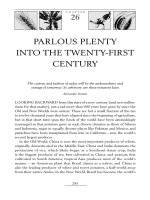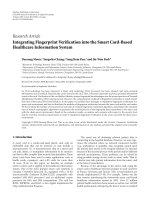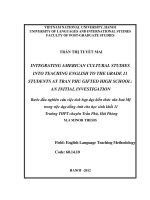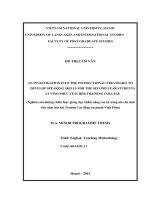Integrating Technologically-Based Laboratory Modules into the Stochastic Processes Curriculum
Bạn đang xem bản rút gọn của tài liệu. Xem và tải ngay bản đầy đủ của tài liệu tại đây (1.04 MB, 11 trang )
Integrating Technologically-Based Laboratory Modules into the Stochastic
Processes Curriculum
Timothy I. Matis
New Mexico State University
USA
Linda Ann Riley
New Mexico State University
USA
James H. Matis
Texas A&M University
USA
Abstract
This paper describes a new and innovative approach to the instruction of applied stochastic
processes at institutions of higher education and a method for introducing this topic to K-12 students for
pre-course motivation. This approach consists of incorporating laboratory modules via digital video
media that present real-world applications of stochastic processes into coursework. The modules engage
the students in problem solving, thereby creating a conceptual framework for learning the subject. The
pedagogy behind this instructional approach and module content is described in this paper. Preliminary
evaluations are presented for assessment purposes from a pilot implementation of the modules at the
collegiate level.
Introduction
The usefulness of stochastic processes in the modeling and analysis of many science and
engineering applications has prompted the recent instructional expansion of this topic. Kao (1997) notes
that this expansion has been spurred by the increase of readily available computational power, which
increases the ability of this modeling approach to more fully analyze real-world problems. Though the
subject is rich in mathematical theory, the learning objective of many students exposed to stochastic
processes is to develop knowledge in the subject for application to their own areas of interests. The
curriculum of many introductory courses at the collegiate level, however, is frequently centered solely on
the theoretical underpinnings of the subject. The topic is typically introduced in a mathematically
rigorous fashion, with limited exposure to its use as a modeling and analysis tool. At the K-12 level,
stochastic modeling is an advanced topic that is rarely introduced to the students. In those rare cases that
it is introduced, the subject is illustrated with simple mathematical exercises that have no practical
application or with projects that the students do not actively work on. Hence, the aforementioned learning
objectives are frequently not addressed by the curriculum of related courses at either level.
This paper describes materials being developed for the instruction of stochastic processes that
promote the development of understanding skills and knowledge-transfer ability by the students. This
work is being funded by the National Science Foundation and consists of technologically-based
laboratory modules that describe real-world problems whose solution involves stochastic modeling and
analysis. Each module consists of a self-contained DVD that is produced through multidisciplinary
collaboration with industry, government, and academia. The students work together in teams to solve the
presented problem using standard concepts covered either in lecture or on the DVD itself. The stochastic
methods addressed by the full set of modules include properties of expectation, Markov chains, Markov
processes, and Markov-renewal theory. Each module spans a period of roughly three weeks of normal
coursework and requires considerable effort by each team. The students are expected to deliver upon
completing each module a comprehensive oral and written report that is directed towards a non-technical
audience. This report should clearly describe the chosen model, justify its assumptions, and describe the
result of their analysis.
The remaining sections of this paper present: the pedagogy behind the modules; a module
targeted to K-12 students for pre-course motivation; modules targeted to higher education; and the
evaluation of a pilot implementation of the modules in a collegiate setting.
93
Module Pedagogy
The pedagogy behind the laboratory modules presented in this paper is based on concepts that
were recently reported by the National Research Council (2000) in the How People Learn (HPL) research
compilation. Though not referenced directly, the remaining discussion in this section draws upon ideas
and research findings presented in this HPL compilation. Clearly there are numerous other learning
theories, however, the HPL concepts seem particularly relevant to the present effort.
The laboratory modules create a knowledge-centered learning environment for the students. This
provides a structure on which they are able to organize and expand their knowledge of stochastic
processes. An open problem is described through the use of digital visual media by industrial
representatives in their own setting. The students start with a preconceived notion of the presented
problem and possible solution methods to the problem. These initial ideas form a base of knowledge
upon which new information is added as models are built, statistical tests performed, and analysis
completed. Erroneous concepts are replaced with correct knowledge as the iterative modeling, testing,
and analysis procedure progresses, thereby encouraging the development of conceptual understanding
rather than factual knowledge.
In particular, as the students begin modeling the problem, they will draw on the material that they
have learned in lecture up to that point. The instructor should help the students organize previously
learned information about stochastic processes in the context of the model. This guidance should be
performed cautiously, however, as the students should not be directed to any particular modeling
approach. The students should be encouraged to “find their way” around the module by using their own
perceived knowledge in creating various models. These initial models may be flawed or not reflective of
the process, yet as the students attempt to parameterize and analyze these flawed models, the
shortcomings of their approach will often be apparent to themselves and the group. This self-correction
process aids in the ultimate conversion of learned material to useful knowledge.
Upon completion, the modules create a context for the conceptualization of future information
acquired in the subject. In a sense, the students become “experts” in the topics of the completed modules,
and mimicking the conceptualization process of “experts”, the students will tend to place new information
acquired about stochastic processes in this established context. Thus, the process of knowledge building
is transformed and expanded gradually in a structured and contextualized manner towards the ultimate
goal of understanding concepts within the discipline.
The creation of the problem contexts by the modules, however, presents the potential risk of overcontextualization of the subject by the students. This would actually hinder the ability of the students to
transfer their knowledge to the solution of other problems outside the realm of the modules. The steps
that we have taken to minimize this risk are two-fold. First, several modules should be introduced to the
students throughout the course of the semester. These modules are not used as semester projects but
rather span a limited time period of only three-four weeks. As such, the students are exposed to several
different contexts throughout the semester, each of which adds to their conceptual framework. The
second step is the reuse of a module topic in multiple contexts. A module may be presented to the
students several times throughout the semester, as they are asked to expand upon a previous problem that
was presented. For example, the instructor may ask the students to relax assumptions made previously or
engage in “what-if” scenarios. Both of these measures will assist in the generalization of the concepts by
the students beyond the specific context of the modules.
Description of K-12 Modules
A DVD with the objective of introducing stochastic processes to students at the K-12 level with
only a first course in statistics is being developed as part of this project. Some materials which introduce
stochastic processes in week-long research workshops for high school Advanced Placement (AP) students
are described in Matis, Kiffe, Renshaw, and Hassan (2003). The participating students at these workshops
are required to have coursework in statistics and calculus, but have little or no exposure to stochastic
94
processes. Several days of basic lectures on the topic are followed by the presentation of some realistic
application. Applications have included problems dealing with stochastic system modeling of ruminant
nutrition, human physiology, and insect population dynamics.
The modules prepared for this broad target audience will be framed by subject-matter experts in
their real-world settings, and each DVD will contain an abundance of data and background resource
material. The DVDs for this audience will also contain a complete solution to the problem, with
references to the scientific literature which address the problem. The learning challenge for the students
will be to integrate the methodology presented in the DVD with the published scientific papers on the
specific example, and then transfer that knowledge to solve similar, closely related examples.
The first part of the initial DVD addresses predicting the arrival time of the Africanized honey
bee (AHB) at a given location. Entomologists at Texas A&M University (TAMU) describe methods for
AHB trapping, and data on the movement of the leading edge of the invasion through Mexico are
provided. Descriptive statistics are discussed and a probability model is developed for predicting future
movements. These predictions are shown to be successful until the arrival of the varroa mite parasite. The
impact of the varroa mite on bee colonies is described by a commercial beekeeper (at B. Weaver
Apiaries).
The second part of the DVD introduces the logistic population growth model, a fundamental
concept in ecology, and its fixed ‘carrying capacity’ parameter. The concept of a more general,
equilibrium population-size distribution, which can be approximated using simple algebraic equations for
its moments, is also presented. The DVD shows a study area at the Welder Wildlife Refuge in south
Texas, with a TAMU entomologist pointing out active AHB colonies at a distance. Data on AHB density
at this site over a 12-year period are presented, and used to parameterize the stochastic model. Students
are challenged to apply the new methodology to predict fox and badger population densities in England
from data given in the literature.
The DVD will be widely disseminated among AP students, as well as first course statistics
students at TAMU, to test its effectiveness. The application to bee and mite population dynamics is
developed extensively in Matis and Kiffe (2000), which illustrates how relaxing certain assumptions, such
as single births and exponential waiting times, can introduce the student to cutting-edge research
problems in stochastic processes.
Description of Higher Education Modules
At the present time, a set of three pilot modules targeted toward the instruction of stochastic
processes at the undergraduate level in a collegiate setting have been produced with Fort Bliss Federal
Credit Union, Sandia National Laboratories, and the Celestica Corporation. The respective topics of these
modules are the allocation of finite resources for the collection of past due loans, reliability and failure
modeling of the Z-machine (an extremely powerful X-ray generator), and the scheduling of direct labor.
These three examples illustrate, respectively, the concepts of Markov chains, Markov processes, and
Markov-renewal theory. The problems presented in each of the modules are not trivial and require the
specification of several assumptions by the students. In many modules, it is necessary for the students to
limit the scope of the problem to facilitate a tractable analysis in terms of project time. The format of the
modules will be described in this section in a general setting and supported with still images from the Fort
Bliss Credit Union module as an example. Following this, a sample implementation of the modules with
pedagogical reference is given.
As previously noted, each module consists of a self-contained DVD that is presented to a team of
students. Upon inserting the DVD into a player, an introductory movie begins that displays clips related
to the project set to music. This introductory piece spans a period of roughly one minute with the student
given the option to skip at any time (Figure 1).
95
Figure 1: Still Images from the Introductory Movie of the FBFCU Module
The main menu of the DVD is presented upon either completion or termination of the
introductory movie. This menu is accompanied by an audio track in which navigation instructions are
given to the viewer. The buttons lead to a series of sub-menus that contain the movies, data, supporting
documents, student resources, and production credits (Figure 2).
Figure 2: Still Images of the Navigational Menus of the FBFCU Module
The movie section of the DVD contains a visual introduction to the company, description of the
problem, and statement of expected deliverables. The movies collectively span a time period of
approximately 1 hour and contain several representatives of the company addressing the students (Figure
3).
Figure 3: Still Images of Representatives from the FBFCU Module
The movies are significantly augmented with overlaid graphics and text to aid in the
understanding of the material and maintain the interest of the viewer in the movie. These rotate in and out
of the presentation approximately every 30 seconds on average (Figure 4) .
96
Figure 4: Still Images of Graphic and Text Overlays from the FBFCU Module
The other sections of the DVD contain additional material that the student might find useful in
solving the problem. These materials are stored in the ROM section of the DVD and may be downloaded
to their computer. The data section is typically divided into two parts. The first contains a description of
the data in Microsoft Word® format and the second contains the data itself as either a Microsoft Excel®
or text file. The supporting documents section contains additional company information, i.e. mission
statements, standard operating procedures, financial reports, etc, in PDF format. The student resources
section contains Mathematica® programs that demonstrate the computer implementation of common
methods used in stochastic processes. The DVD is enclosed in a case that displays artwork relevant to the
problem and credit to the production team.
As an example, consider the following module implementation plan for an introductory stochastic
processes course. When the instructor is near completion of his/her lectures on Markov chains, the
instructor organizes teams of 3-4 students and assigns them the FBFCU module. To support the students
with this assignment, the instructor may want to set aside one lecture a week as a laboratory period in
which he/she meets with the teams to monitor their progress. The students view the DVD either as a
team or individually and meet to discuss the problem. A preliminary conceptual framework is
established by the each student through their initial insights into the problem and ideas of possible
solution methods. This framework is subsequently reshaped as the students meet as a team to discuss the
problem. At this stage, a preliminary model will be built by the team, which may or may not involve
Markov chains. As the students attempt to parameterize and perform statistical tests on the model they
created, they may discover that the model originally created needs to be modified. For example, states
may need to be added, removed, or reclassified, the model may need to be modified for the Markov
property to be reasonable, the order of the Markov chain may need to be increased, etc. Their conceptual
framework is continually updated with this new information throughout this process and their knowledge
base corrected. Once justified, the model will be modified and analyzed repetitively to optimize the
performance of the system, whereupon a written and oral report will be generated. The students’ base of
knowledge is now at the level at which the final model was created. To avoid over-contextualization, the
instructor may ask the students to vary some assumptions of the problem or assign another problem
whose solution involves Markov Chains. As the lectures progress through the next topic, say Markov
Processes, the instructor will repeat the same exercise with the Celestica module and the process starts
over.
Some common comments received by the laboratory instructor (teaching assistant) of the 415/515
introductory stochastic processes course at New Mexico State University related to the fall 2003
implementation of the FBFCU module were: 1) Do we use all observations when calculating the
transition probabilities of an absorbing Markov Chain or only those in which the process was absorbed,
2) I went ahead and assumed the chain was of first order since that is what we covered primarily in class,
that is not a big a deal, is it?, 3) The steady state distribution ends up with everything in the two
absorbing states, how do I get steady state probabilities for the other states?, 4) What is the state space of
the process?, and 5) What do I do with the model now that I solved it?. These common questions came
97
out of student attempts to solve this problem and each exposes a deficiency in the student’s current
knowledge base, i.e. 1) correctly interpreting data, 2) understanding the Markov property, 3) interpreting
transient states, 4) creating models reflective of the process that answer desired questions, and 5) using
the model to optimize a process. It is important to note that the students discovered this knowledge
deficiency themselves and corrected it through limited intervention by the instructor. In addition, this
range of questions spans all phases of the stochastic modeling process, i.e. model formulation,
parameterization, and analysis. Some groups went through several model building iterations and raised
several similar types of questions before creating a model that performed acceptably for them. This
information correction process expands and refines the base of knowledge possessed by the students,
towards the development of fundamental understanding in the subject.
Module Evaluation
At the present time, evaluations have been collected for the Fort Bliss Credit Union and Celestica
higher education modules from pilot implementations in the Industrial Engineering (IE) 415/515
introductory stochastic processes course and the IE 630 Engineering Logistics course at New Mexico
State University in the fall 2003 semester. The purpose of these evaluations is to assess the efficacy of the
modules in achieving the desired outcomes of: 1) an improved learning environment for students enrolled
in introductory stochastic processes courses, 2) higher levels of understanding of the course material
among students, and 3) higher levels of knowledge transfer from this course to others where the theory is
applied. In establishing the universal principles of utility, feasibility, propriety, and accuracy in the
evaluation, this evaluation plan incorporates the assessment methods of Lewis and Seymour
(www.wcer.wisc.edu/nise/CL1/flag/cat/attitude/attitude1.htm) and of Slater (www.wcer.wisc.edu/nise/
CL1/flag/cat/perfass/perfass1.htm), along with the statistical techniques of Jaeger (1983), and the program
evaluation standards of the Joint Committee on Standards for Educational Evaluation (JCSEE, 1994).
The evaluations presented in this paper are only a part of those that have been and will be
collected. The full assessment plan additionally includes faculty peer-review of the modules and student
performance evaluations, which are in the process of being collected and organized. However, the
evaluations currently available and presented in this section provide preliminary evidence to the efficacy
of this educational approach. A copy of the attitudinal survey is contained in the appendix of this paper
and should be consulted for the full interpretation of stated findings.
Qualitative Response
The qualitative response section of the attitudinal survey administered to the IE 630 course in fall
2003 for the Celestica module is summarized below. Selected comments were extracted from the surveys
and are reported verbatim.
In general, the student teams liked working on “real” problems in a group setting. From
evaluations of the module, students reported these comments: “The Celestica problem was excellent. It
was great to deal with a real world complex problem.” And this comment: “The module was worthwhile.
It lends a far more realistic approach to the theory we covered, a definite improvement over the
imaginary scenarios normally used to present concepts.”
The students also felt DVD delivery medium was effective, enjoyable, and generally of high
quality. The alternative teaching approach to stochastic processes also received high marks from the
students. “I felt the module was a very good teaching method. Projects help an individual get a better
grasp of material and a project that is a real world example is even better. Also in the module, a student
gets to see if his way of solving the problem compares to an IE in the workforce.”
An unintended positive consequence of the module was the new found sense of confidence some
students realized when working with real-world “noisy” problems. “It was eye-opening to realize how
little some companies know about process improvement and logistics philosophies. That realization made
me feel much more confident in my own newly acquired skills.”
98
The evaluations were mixed yet generally positive on whether the students felt that they learned
more using the modules than they would have otherwise. “I think the module was a useful tool to discuss
how problems actually arise and are perceived inside of a factory. I didn’t find the supporting
documentation useful, more distracting than anything, but if we’d had longer to work on the problem, it
may have been useful. Again, however, from a real world perspective, that also occurs, having
information available that isn’t really useful in solving the problem.”
Students main dislikes centered around the pace of the modules and the lack of a clear definition
on how to apply stochastic processes in solving the problem. “I felt that the only downside was the time
allotted to do the work on this module. I feel if it could have given earlier, it wouldn’t have been so
rushed or we could have done a better job of analyzing.”
Quantitative Response
The quantitative response sections of the attitudinal survey given in Appendix A which was
administered to the IE 415/515 course in fall 2003 for the FBFCU and Celestica modules are summarized
below in Figures 6 and 7 respectively. There were at total of 12 respondents to the FBFCU survey and 14
respondents for the Celestica module, which is a subset of the 18 people to which the modules were
assigned.
Figure 6: Quantitative Response to the IE 415/515 Implementation of the FBFCU Module
Figure 7: Quantitative Response to the IE 415/515 Implementation of the Celestica Module
99
A general comparison of these quantitative results reveal that 1) the students liked the FBFCU
module more than the Celestica module, 2) the students felt the modules were implemented in too short a
time frame, and 3) the students were mixed on their thoughts of the modules efficacy as a learning tool. It
is important to note that the Celestica module was implemented in the final three weeks of the semester
during final examinations. The majority of students expressed verbal disapproval for this timing.
Conclusion
Materials developed for the instruction of stochastic processes at the K-12 and higher education
levels have been described in this paper. These materials were developed based on the pedagogy
presented in the How People Learn research compilation, and they create a knowledge-centered learning
environment. Preliminary evaluations are presented from pilot implementations of the modules to assess
the adequacy of this educational approach.
Acknowledgement
This material is based upon work supported by the National Science Foundation under Grant No.
0230643. A copy of the DVD laboratory modules described in this paper may be obtained free of charge
by request. Please visit the website and follow the “request
evaluation copy” link.
References
Jaeger, R. (1983). Statistics: a Spectators Sport. Beverly Hills, CA: Sage Publications.
Joint Committee on Standards for Educational Evaluation. (1994). The Program Evaluation Standards,
Second Edition. Beverly Hills, CA: Sage Pulications.
Kao, E. (1997). An Introduction to Stochastic Processes. New York: Duxbury Press.
Lewis, E. & Seymour, E. (n.d.). Attitudinal Survey. Field-tested Learning Assessment Guide (FLAG),
College Level One Team. Available online at: www.wcer.wisc.edu/archive/cl1/flag/extra/
download/cat/attitude/attitude.pdf.
Matis, J., Kiffe, T., Renshaw, E. & Hassan, J. (2003). A simple saddlepoint approximation for the
equilibrium distribution of the stochastic logistic model of population growth. Ecological
Modelling, 161: 239-248.
Matis, J. & Kiffe, T. (2000). Stochastic Population Models. New York: Springer.
National Research Council (2000). How People Learn: Brain, Mind, Experience, and School. J.
Bransford, A. Brown &R. Cocking, R.. (Eds.). Washington DC: The National Academies Press.
Slater, T. (n.d.). Performance Assessment. Field-tested Learning Assessment Guide(FLAG), College
Level One Team. Available online at: />perfass/perfass1.htm.
100
Paper Appendix: NSF Pilot Project Evaluation
Teaching Theoretical Stochastic Modeling Courses Using Industrial Partners and
Their Applied Problems
Background
The goal of this NSF pilot project is to create an innovative learning environment that
incorporates “real-world” applications into Industrial Engineering courses that include (IE) the study of
stochastic processes. This is accomplished through the development of a set of technology-based
modules developed in conjunction with several industrial partners. Therefore, the purpose of this
evaluation is to determine:
1. To what extent were the goals met;
2. How might this pilot project be improved for further development in the future;
3. What were the strengths and weaknesses of the multimedia modules associated with the
course; and
4. Your opinion on how this approach supports the overall program of study in industrial
engineering.
Ultimately, this evaluation will assist the project principal investigators with refining the content and
delivery of the modules for future offerings.
Part 1
As relayed in class with the introduction of the modules, the outcomes of this project include an
improved learning environment, higher levels of student transferal of knowledge, the exposure of students
to a number of different technological tools, the integration of advanced technology in the design and
creation of the modules, and a curriculum package that is highly transferable to other programs and
universities offering stochastic modeling courses.
Therefore, for each of the following topics, please circle the number that best describes your
response on a scale of 1 to 5, where 1 means your strongly agree and 5 means that you strongly disagree.
What module are you evaluating in this survey?
Fort Bliss
Celestica
Sandia National Laboratories
1.1 The use of a multimedia module for understanding
industrial engineering problems was helpful.
1.2 The use of a multimedia module for solving
industrial engineering problems was helpful
1.3 The video portion of the module was effective.
1.4 The video portion of the module was wellproduced.
1.5 The overall quality of the video was excellent.
1.6 The additional resources portion of the module
helped me understand the problem better.
1.7 The audio quality of the DVD was effective?
Strongly
Agree
Strongly
Disagree
1
2
3
4
5
1
2
3
4
5
1
2
3
4
5
1
2
3
4
5
1
2
3
4
5
1
2
3
4
5
1
2
3
4
5
101
Part 2
The second set of questions investigates specifics about the integration of the modules into the course
design and the instructor’s knowledge level and methods with respect to the module. Please answer the
following questions by placing an X in a box corresponding to 1 to 5.
1
2.1 Instructor’s apparent
familiarity with the material
presented on the module.
2.2 Instructor’s ability to
convey knowledge about the
subject matter on the module.
2.3 Instructor’s attitude toward
using the module.
2.4 Instructor’s impartiality in
grading module work.
2.5 Organization of the module
integration into the course.
2.6 The instructor motivated
me to do my best on the
module.
2.7 I have learned....because of
using the module.
2.8 The pace of the module
presentation was...
2.9 Would you recommend
that the instructor use this
module again?
2
3
4
5
Extensive
Limited
Excellent
Poor
Enthusiastic
Bored
Fair
Biased
Excellent
Poor
Strongly
agree
Strongly
disagree
More than
expected
Less than
expected
Too fast
Too slow
Definitely
yes
Definitely
no
Part 3
This section of the evaluation asks you to comment on the instructor’s strengths and areas for
improvement with respect to teaching this module as a component of this course. It also asks you to
comment on how the module could be better developed for the future.
3.1 How could the instructor improve the integration of this module into course material with regard to
content, presentation, utilization of class time, balance between book, modules and lecture? What would
you change for future offerings of this course using this module? Please explain your answers below.
Use additional paper if necessary.
3.2 How might the module be improved? Please comment on video, audio, content, supporting files, etc.
Use additional paper if necessary.
102
Part 4
4.1 In your opinion, do you feel that this module was a worthwhile addition to the course material? Why
or why not?
4.2 Is there anything else you would like to add to this module evaluation that hasn’t been covered thus
far?
103









